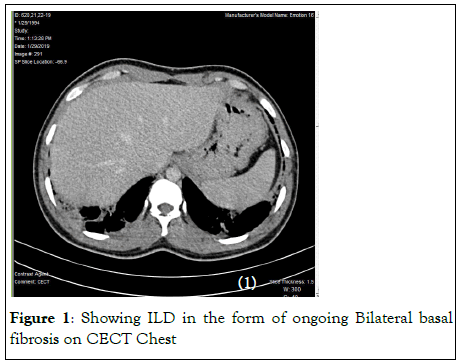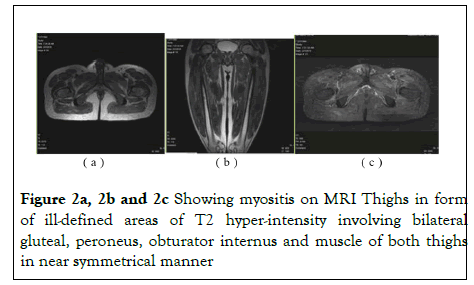Rheumatology: Current Research
Open Access
ISSN: 2161-1149 (Printed)
+44-77-2385-9429
ISSN: 2161-1149 (Printed)
+44-77-2385-9429
Case Report - (2021)
Anti-Synthetase Syndrome (ASS) is a rare autoimmune disorder characterized by Interstitial Lung Disease (ILD), inflammatory myositis, fever, Raynaud’s phenomenon, mechanic hand, and inflammatory polyarthritis in the setting of antibodies against amino acyl-transfer RNA synthetases, with anti-Jo-1 antibody being the most common. This diagnosis should always come to mind in patients that present with signs of myositis, dermatomyositis, or polymyositis associated with interstitial lung disease. In this paper, we report a rare case of pyrexia of unknown origin in a 25-year-old man who presented with a 01-month history of fever, symmetrical polyarthralgia, myalgia, weight loss of 3 kg, and progressive muscle weakness associated with dyspnoea. Initially evaluation for fever was negative. Further tests revealed raised acute phase reactant, positive ANA with Cytoplasmic pattern, positive SSA antibodies & elevation of anti-Jo-1 antibodies and evidence of myositis on MRI. A diagnosis of antisynthetase antibody syndrome was made and the patient showed good response to treatment with corticosteroids and methotrexate.
Anti-synthetase syndrome (ASS) is an autoimmune disease characterized by autoantibodies against one of many aminoacyl transfer RNA (tRNA) synthetases with clinical features that may include interstitial lung disease (ILD), non-erosive arthritis, myositis, Raynaud’s phenomenon, unexplained fever and/or mechanic’s hands [1]. Anti-synthetase syndrome is an idiopathic inflammatory myopathy (IIM), with a higher prevalence of ILD compared to dermatomyositis (DM) and polymyositis (PM), with which it shares many features. The ILD in anti-synthetase syndrome patients is often severe and rapidly progressive, causing much of the increased morbidity and mortality [2]. Fever is one of the rare manifestations of ASS and ASS manifesting as PUO even less common. Various clinical signs of ASS being Imnterstitial pneumopathy (90%), Myositis (78-91%),Arthropathy (64-83%), Ryanauds phenomenon (62%), Fever(20%) and dermatologicl manifestations (17-71%). On the following paper we report a rare case of ASS in young male presenting as unexplained fever who was diagnosed as ASS and managed conservatively with corticosteroid and methotrexate.
A 25 years old male with no known prior co morbidities presented with complaints of moderate to high grade fever with evening rise of 25 days duration, gradually progressive painful swelling and polyarthritis of both hand and feet (Onset day 3 of fever) , pain lower back radiating to both lower limbs with proximal muscle weakness, progressive dyspnoea on climbing stairs and weight loss of 03 Kgs in one month. However, there was no history of associated cough, chest pain, orthopnoea, PND. No h/o alopecia, skin rash, oral ulcer, raynaud’s phenomenon, bladder and bowel dysfunction. On physical examination patient was found to be febrile with proximal muscle weakness of both lower limb, hepatosplenomegaly and B/L basal crepts. Initial evaluation of patient for fever was inconclusive. He was worked up in lines of PUO. Further evaluation revealed elevated acute phase reactant, increased muscle enzymes(CPK), ANA (IIF) cytoplasmic pattern with ANA profile showing Jo 1 and Anti SSA, e/o ILD in form of mild diffusion defect on DLCO and ongoing B/L basal fibrosis on CECT[figure 1] and e/o myositis on MRI Thighs in form of illdefined areas of T2 hyper-intensity involving B/L gluteal, peroneus, obturator internus and muscle of both thighs in near symmetrical manner[Figure 2a,2b and 2c]. Hence Diagnosis of Antisynthetase syndrome was considered and he was started on steroid and DMARDs. He responded positively with complete resolution of myositis, polyarthritis and fever in two weeks. On follow up after 06 month the patient remained asymptomatic.

Figure 1: Showing ILD in the form of ongoing Bilateral basal fibrosis on CECT Chest

Figure 2a, 2b, 2c: Showing myositis on MRI Thighs in form of ill-defined areas of T2 hyper-intensity involving bilateral gluteal, peroneus, obturator internus and muscle of both thighs in near symmetrical manner
The Anti-Synthetase Syndrome (ASS) is a rare, systemic autoimmune disease involving multiple organs. The presence of anti-aminoacyl t-RNA antibodies (anti-ARS antibodies) especially anti-Jo-1 antibody is the hallmark of the disease [3]. Antisynthetase syndrome was first described by Marguerie and co-workers in 1990. It was described as a triad of polymyositis, diffuse interstitial lung disease and serum autoantibodies to aminoacyl transfer RNA synthetase (anti-ARS) [4,5]. The pathogenesis of antisynthetase syndrome involves autoantibodies to eight of the aminoacyls– transfer RNA synthetases. In ASS, 68-87% of the anti-ARS consists of anti-jo-1 antibody [6]. In ASS fever is one of the rare manifestations with incidence of 20%.[3]. Our review of literature reveals there is no case ASS reported till date with PUO as manifestation. The major determinant of morbidity and mortality in ASS is ILD [7]. However, there were minimal features of ILD in our patient and PUO was the primary complaint. Prednisone in the dose of 1mg/kg/day remains the drug of choice for the treatment of this disorder. High dose of steroid is used in the initial phase. Remission is achieved in 25-68% of cases when high dose of corticosteroids is given as part of initial therapy [8]. Our patient was also managed with steroid and DMARDs to which he responded well and became asymptomatic after 02 weeks of treatment
It is important for clinicians to keep in mind Rheumatologic cause when prolonged fever cannot be explained by tropical infections. The presence of joint pain, raynaud’s , muscle pain/ weakness and clinical finding suggestive of ILD in chest points towards the above. Although uncommon, Anti synthetase syndrome must be kept as a differential when the patient has fever along with myositis, raynaud’s and even minimal features suggestive of ILD.
Citation: Kumar A (2021) A Rare Disease With Its Uncommon Presentation - Antisynthetase Syndrome Presenting As Unexplained Fever. Rheumatology (Sunnyvale). 11:294.
Received: 30-Dec-2020 Accepted: 26-Aug-2021 Published: 06-Sep-2021 , DOI: 10.35248/2161-1149.21.s16.002
Copyright: © 2021 Kumar A. This is an open-access article distributed under the terms of the Creative Commons Attribution License, which permits unrestricted use, distribution, and reproduction in any medium, provided the original author and source are credited.